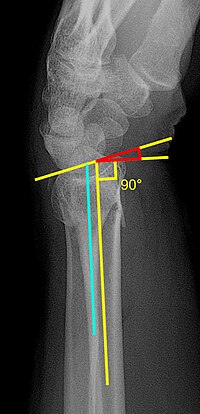
Photo from wikipedia
Background and purpose Classification of fractures can be valuable for research purposes but also in clinical work. Especially with rare fractures, such as distal ulna fractures, a treatment algorithm based… Click to show full abstract
Background and purpose Classification of fractures can be valuable for research purposes but also in clinical work. Especially with rare fractures, such as distal ulna fractures, a treatment algorithm based on a classification can be helpful. We compared 3 different classification systems of distal ulna fractures and investigated their reliability and reproducibility. Patients and methods patients with 97 fractures of the distal ulna, excluding the ulnar styloid, were included. All fractures were independently classified by 3 observers according to the classification by Biyani, AO/OTA 2007, and AO/OTA 2018. The classification process was repeated after a minimum of 3 weeks. We used Kappa value analysis to determine inter- and intra-rater agreement. Results The inter-rater agreement of the AO/OTA 2007 classification was judged as fair, ĸ 0.40, whereas the agreement of AO/OTA 2018 and Biyani was moderate at ĸ 0.42 and 0.43 respectively. The intra-rater agreement was judged as moderate for all classifications. Interpretation The differences between the classifications were small and the overall impression was that neither of them was good enough to be of substantial clinical value. The Biyani classification, being developed specifically for distal ulna fractures, was the easiest and most fitting for the fracture patterns seen in our material, but lacking options for fractures of the distal diaphysis. Standard radiographs were considered insufficient for an accurate classification. A better radiographic method combined with a revised classification might improve accuracy, reliability, and reproducibility.
Journal Title: Acta Orthopaedica
Year Published: 2022
Link to full text (if available)
Share on Social Media: Sign Up to like & get
recommendations!